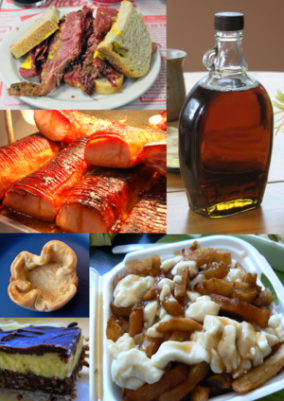Lesson "Canadian Cuisine"
Lesson
Canadian Cuisine
Aims:
- to develop students’ speaking skills;
- to train students in listening comprehension;
- to teach students to compare, analyze and make their own conclusions;
- to develop positive attitude towards the world around us;
- to develop creative thinking;
Materials: after reading and after listening tasks, texts for reading, multimedia complex, tests.
PROCEDURE
- Warm up.
Answer the questions.
- What do you know about Canadian national cuisine?
- What the most famous Canadian dishes can you name?
- What food do the Canadian people like?
2. Reading.
Vocabulary.
Read, translate using the dictionary and pronounce correctly
|
Smorgasbord, subsequent waves, pan-fried bread, shantytown, Ginger beef |
Cuisine
Canadian cuisine varies widely depending on the regions of the nation. The former Canadian prime minister Joe Clark has been paraphrased to have noted: "Canada has a cuisine of cuisines. Not a stew pot, but a smorgasbord."
The three earliest cuisines of Canada have First Nations, English, and French roots, with the traditional cuisine of English Canada closely related to British and American cuisine, while the traditional cuisine of French Canada has evolved from French cuisine and the winter provisions of fur traders. With subsequent waves of immigration in the 18th and 19th century from Central, Southern, and Eastern Europe, and also from China, the regional cuisines were subsequently augmented. Canada is the world's largest producer of Maple syrup.
 Cultural contributions
Cultural contributions
Since the beginning, Canadian food has been shaped and impacted by continual waves of immigration, with the types of foods and from different regions and periods of Canada reflecting this immigration. The traditional cuisine of the Arctic and the Canadian Territories is based on wild game and Inuit and First Nations cooking methods; conversely bannock, which is popular across First Nations and Native American communities throughout the continent, is a method for making pan-fried bread introduced to their culture by Scottish fur traders.
The settlers and traders from the British Isles account for the culinary influences of early English Canada in the Maritimes and Southern Ontario (Upper Canada) while French settlers account for the cuisine of southern Quebec (Lower Canada), Northern Ontario, and New Brunswick. Many of the more south western regions of Ontario have strong Dutch and Scandinavian influences, while German, Ukrainian, and Polish cuisines are strong influences to the cuisine of the western Canadian provinces. Also noteworthy is the cuisine of the Doukhobors, Russian-descended vegetarians.
The Waterloo, Ontario, region has a tradition of Mennonite and Germanic cookery.
The Jewish immigrants to Canada during the late 1800's also play a significant role to foods in Canada. The Montreal-style bagel and Montreal-style smoked meat are both food items developed by Jewish communities living in Montreal.
Much of what are considered "Chinese dishes" in Canada are more likely to be Canadian or North American inventions, with the Chinese of each region tailoring their traditional cuisine to local tastes. This Canadian Chinese cuisine is widespread across the country, with great variation from place to place. The Chinese buffet, although found in the U.S. and other parts of Canada, had its origins in early Gastown, Vancouver, c.1870 and came out of the practice of the many Scandinavians' working in the woods and mills around the shantytown getting the Chinese cook to put out a steam table on a sideboard, so they could "load up" and leave room on the dining table (presumably for "drink"). Ginger beef is a popular Chinese food purportedly originating in Western Canada.
The cuisines of Newfoundland and the Maritime provinces derive mainly from British and Irish cooking, with a preference for salt-cured fish, beef, and pork. Ontario, Manitoba and British Columbia also maintain strong British cuisine traditions.
3. Understanding the text.
Choose an episode from the text that you like the best and retell it.
4. Work in pairs.
Choose a partner and ask him questions about Australian cuisine.
5. Work in pairs. Make up your dialogue using the expressions from the text below.
Canadian cuisine
three earliest cuisines
the traditional cuisine
the settlers and traders
the Jewish immigrants
6. Listening
Listen to the following information about Beverages and do the tasks which follow.
Maple syrup
 Is there anything more Canadian than maple syrup? "Sugaring time," that brief space between winter and spring when the snow starts to melt and the sap begins to flow in the maple groves evokes romantic images of their pioneering past. Despite the technological advances in farming techniques, production of maple syrup remains largely a "family operation," essentially unchanged from its traditional past.
Is there anything more Canadian than maple syrup? "Sugaring time," that brief space between winter and spring when the snow starts to melt and the sap begins to flow in the maple groves evokes romantic images of their pioneering past. Despite the technological advances in farming techniques, production of maple syrup remains largely a "family operation," essentially unchanged from its traditional past.
The skill of collecting and processing the sweet sap of the sugar maple was known and valued by the native peoples of eastern North America long before the arrival of European settlers. There is even an Iroquois legend to explain the discovery of maple syrup. As the story goes, an Iroquois chief yanked his hatchet out of the maple tree where he had left it, and set off for a day of hunting. He didn’t notice the deep gash his blade had left in the tree, but all day a colourless liquid trickled from the gash, collecting in a birchbark bowl that was leaning against the maple tree. The following day his wife noticed the full bowl, and thinking it was water, used the liquid to cook a venison stew. The resulting sweet stew was a happy accident, beginning the culinary tradition of maple-cured meats.
Maple syrup and maple sugar were used during the American Civil War and by abolitionists in the years prior to the war because most cane sugar was produced by Southern slaves. It has played an important role during WWII too, because food rationing encouraged people to get alternative sources to sweetening foods, and maple trees are very common native trees in northeastern North America. Also, maple syrup is considered a healthier alternative to white sugar and other sweeteners.
Maple products are considered emblematic of Canada, in particular Quebec, and are frequently sold in tourist shops and airports as souvenirs from Canada. The sugar maple’s leaf has come to symbolize Canada, and is depicted on the country’s flag. Several US states, including New York, Vermont and Wisconsin, have the sugar maple as their state tree.
A maple leaf is on the coat of arms of Canada, and is on the Canadian flag. The maple is a common symbol of strength. Maple leaves are traditionally an important part of Canadian Forces military regalia, for example the military rank insignia for generals use maple leaf symbols.
7. Understanding the text.
Listen to the text. Then read the statements below and put “T” for the statements and “F” for the false ones.
- Maple syrup and maple sugar were used during the Canadian Civil War.
- The skill of collecting and processing the sweet sap of the sugar maple was known and valued by the native peoples of eastern South America long before the arrival of European settlers.
- There is even an Iroquois legend to explain the discovery of maple syrup.
- Maple syrup and maple sugar were used during the American Civil War and by abolitionists in the years prior to the war because most cane sugar was produced by Southern slaves.
- The sugar maple’s leaf has come to symbolize Canada, and is depicted on the country’s flag.
- The maple is a common symbol of wealth.
- Maple leaves are traditionally an important part of Canadian Forces military regalia.
- Work in pairs. Make a list of seven questions to see if your classmates can answer them.
- Homework.
Make up your own quiz about Canadian cuisine.


про публікацію авторської розробки
Додати розробку
